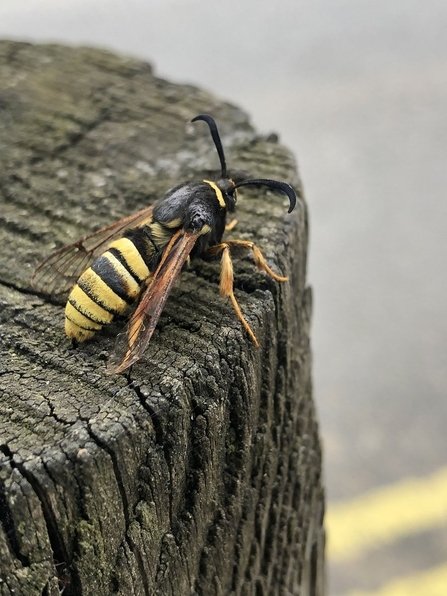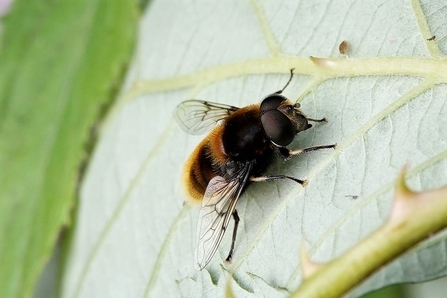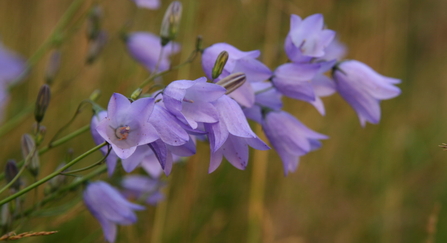We were thrilled to see so many of you – and so much wildlife! – out enjoying the glorious sunshine in July. From the lofty heights of Warton Crag in Carnforth to the boggy expanse of Chat Moss in Greater Manchester, our nature reserves and other sites were brimming with life. Here is just a taste of what our staff, volunteers and visitors spotted.
Latest wildlife sightings – July 2021

Lunar hornet moth by John Wright
Brockholes
Talk about a butterfly boom! You couldn’t move for butterflies and moths at Brockholes nature reserve last month. The Lepidoptera list included:
- Small skipper
- Small white
- Common blue
- Green-veined white
- Red admiral
- Meadow brown
- Peacock
- Gatekeeper
- Small copper
- Holly blue
- Cinnabar moth caterpillars
- Spindle ermine moth
And it wasn’t only these more common species – July was white-letter hairstreak time, with lucky visitors spotting these tiny butterflies flitting around the bramble bushes near Boilton Wood. If that wasn’t enough, they also recorded a purple hairstreak, while John Wright saw and photographed the incredible lunar hornet moth pictured above. These hornet-mimics overwinter not once, but twice as caterpillars, feeding on sallows and willows.
As well as exciting insects, July had the ‘awww’-factor, with young animals getting bolder and coming out into the open more often. Roe deer kids followed their mothers around the fields; whitethroat, blackcap, long-tailed tit, sedge warbler and kestrel chicks begged for food from their parents; and the trails filled with tiny frog and toadlets. The in focus team even spotted common sandpiper chicks on Number One Pit from their vantage point in The Lookout.
Warton Crag
Though some of Warton Crag’s rarest butterflies have largely had their season (though small pearl-bordered and pearl-bordered fritillaries may have a second brood in August), July was a great month to spot another limestone beauty, the dark green fritillary. Visitors also spotted cinnabar moths, peacock caterpillars feeding from nettles (their only food plant – so please let your nettles grow!), ringlets and small skippers.

Furry dronefly by Janice Sutton
Mere Sands Woods
We were thrilled to see Janice Sutton record a number of beautiful hoverflies at Mere Sands Wood, including the common drone fly, tiger hoverfly, snouted duckfly and gorgeously fuzzy furry drone fly (pictured), which is a fantastic bumblebee mimic.
With sun-dappled woodland glades and wildflower meadows-a-plenty, there were also lots of butterfly sightings at Mere Sands Wood, including red admiral, small copper and green-veined white. Add in common darter and black-tailed skimmer dragonflies, kingfishers and little egrets, and the opening of our brand new visitor centre and cafe, and you have a recipe for some wonderful nature moments.
Chat Moss
There were two exciting pieces of news from the Chat Moss peatlands in Greater Manchester last month. We’re thrilled to say that after 150 years of local extinction, white beak-sedge is back on-site following a successful reintroduction by Josh Styles of the North West Rare Plant Initiative, and in large numbers too! As if that wasn’t enough, after reintroducing lesser bladderwort to another Chat Moss site, the total population estimate for the Greater Manchester peatlands is now thought to be around one million individual plants!
Wood-carving leafcutter bee making her nest (https://youtu.be/5vpzNt3EvVA)
Wood-carving leafcutter bee at Lightshaw Meadows
Lightshaw Meadows
A very exciting insect was spotted at Lightshaw Meadows nature reserve in Abram last month. The wood-carving leafcutter bee (above) is one of seven species of leafcutter found in the UK, and is one of the largest and rarer leafcutters. They are more commonly found in the south of England and nest in dead wood, including old fence posts (like this one!).
Middleton Nature Reserve
It seems to be a good year for lunar hornet moths in Lancashire, as one was spotted at Middleton Nature Reserve as well as Brockholes! And this wasn’t the only magical moth recorded here – visitors also spotted the gorgeous shaded broad-bar moth (a lover of grassy vegetation), and a burnet companion moth, which flies in the sunshine and warm, overcast weather, flashing its bright orange hindwings.
Other sightings of the winged variety included a female gadwall with chicks, a green sandpiper calling from the western marsh, and a kingfisher by the No Swimming Pond. This species doesn’t normally show at Middleton NR until autumn, so seeing one in July was a lovely surprise.

Harebells by Kieron Huston
Heysham Nature Reserve
Some of the top wildlife sightings at Heysham Nature Reserve in July included yet more lunar hornet moths! These were spotted along with a new moth for Lancashire – the sharp-angled carpet: a moth of hedgerows and woodland rides – and a purple hairstreak butterfly.
Other delights included brilliant blue harebells, showy bullfinches, fluttering gatekeeper butterflies and plenty of bunnies.
Heysham harbour
After a slow start, it’s been a great season for Mediterranean gulls at Heysham harbour. In July, both adults and juveniles were recorded on Red Nab, on the beach and on the south shore, with a high-count of 27. Manx shearwaters were spotted by Heysham Bird Observatory volunteers carrying out their sea-watches, and a common sandpiper was spotted on Red Nab at high water. The skear remained a great place to see curlew, with more than 150 foraging alongside the odd female eider duck and a small group of knot still sporting the remnants of their summer plumage.
Some of the more unusual sightings from Heysham harbour last month included a green woodpecker yaffling from the copse behind Red Nab, and more than 10 lion’s-mane jellyfish washed up on the south shore! These stunning jellyfish get their name from their long, flowing mane of tentacles which can grow up to 3m long! They can give a nasty sting even when they’re dead, so please do admire them, but don’t touch.
What have you seen on our nature reserves recently? We’d love to hear all about your wildlife sightings in Lancashire, Manchester and North Merseyside – click one of the icons below to share them with us on social media.

